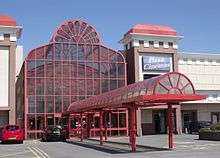Dunmail
Dunmail is a legendary king of Cumberland associated with Dunmail Raise. According to tradition, Dunmail was the last king of Cumberland, and buried beneath the cairn at Dunmail Raise after having been slain by the English. Dunmail Raise, meaning "Dyfnwal's Cairn", may well be named after the historical Dyfnwal ab Owain, King of Strathclyde.

Legend
According to local legend, Dunmail, king of Cumberland, was attacked by the combined forces of Edmund and Malcolm and retreated into the heart of the Lake District. Dunmail met the kings in battle in the pass that divides Grasmere from Thirlmere but was defeated, was killed in the fight (it is said at the hands of Edmund himself) and his sons were subsequently blinded by the victors. Some of the surviving Cumbrians, taken prisoner by Edmund, were ordered to collect rocks to pile on Dunmail's body, forming a cairn that still exists to this day and gives the pass its modern name, Dunmail Raise. Others of Dunmail's warriors fled with the crown of Cumberland, climbing into the mountains to Grisedale Tarn below Helvellyn, where they threw it into the depths to be safe until some future time when Dunmail would come again to lead them. Every year the warriors are said to return to the tarn, recover the crown and carry it down to the cairn on Dunmail Raise. There they strike the cairn with their spears and a voice is heard from deep inside the stones, saying "Not yet, not yet; wait awhile, my warriors."[1]
Dunmail features as a character (and his death is described) in the classic story of the Vikings in Lakeland Thorstein of the Mere by W. G. Collingwood. He is mentioned briefly in Cue for Treason by Geoffrey Trease.
At an earlier date, the story was versified by William Wordsworth:
- They now have reach'd that pile of stones
- Heap'd over brave king Dunmail's bones,—
- He who once held supreme command,
- Last king of rocky Cumberland.
- His bones and those of all his power,
- Slain here in a disastrous hour.
As far as written history is concerned, the name of the "Dumbalrase stones" is recorded in a map of the 1570s,[2] and the association of the cairn with the king is recorded as early as the seventeenth century, when John Ogilby wrote that "Dunmail-Raise-Stones" were erected by a Cumbrian ruler of that name to mark the frontier of his kingdom.[3] The specific association with the historic invasion of the Kingdom of the Cumbrians in 945 appears repeatedly in the 1700s, in the works of the antiquaries Thomas West,[4] Thomas Pennant.[5] and William Gilpin.[6] Joseph Nicolson and Richard Burn gave both versions of the story.[7]
William Wordsworth mentions the legend of Dunmail in Canto First of 'The Waggoner', ll. 209-14; composed 1805, published 1819.[8]
References
- Carruthers, F. (1979) People Called Cumbri. Robert Hale: London
- Ogilby, T. (1699) The Traveller's Guide: Or, A Most Exact Description Of The Roads Of England. Abel Swall: London
- West, T (1784) A Guide to the Lakes, in Cumberland, Westmorland, and Lancashire. 3rd. ed., Law, Richardson & Urquhart, Pennington: London and Kendal
- Pennant, T. (1776) A Tour in Scotland and Voyage to the Hebrides; MDCCLXXII. 2nd. ed, Benjamin White: London
- Gilpin, W. (1786). Observations, relative chiefly to Pictureseque Beauty, Made in the Year 1772, On several Parts of England; particularly the Mountains and Lakes of Cumberland, and Westmoreland. R. Blamire: London.
- Nicolson, J. & Burn, R. (1777), History and Antiquities of Westmoreland and Cumberland. Strahan and Cadell, London
- William Wordsworth, The Collected Poems of William Wordsworth. Wordsworth Editions Limited, 1995.
External links
- Cumbria: The Age of Kings, a site exploring the legend of King Dunmail and Cumbrian Dark Age history in general.